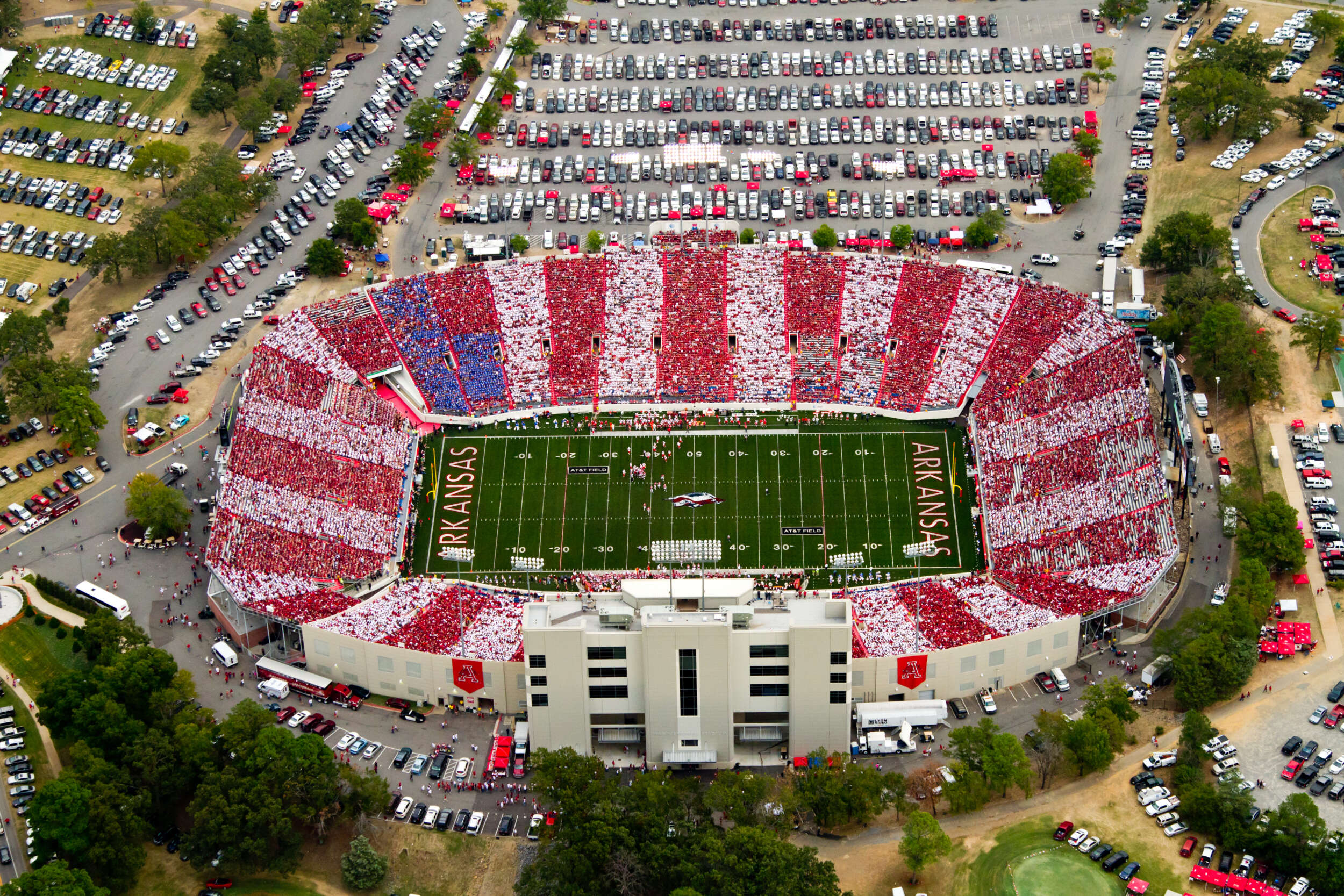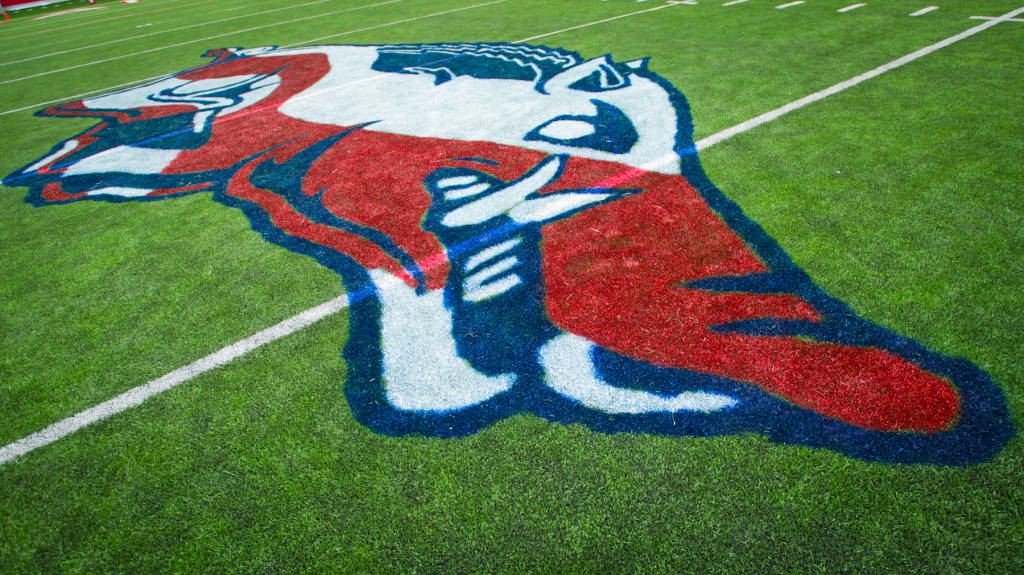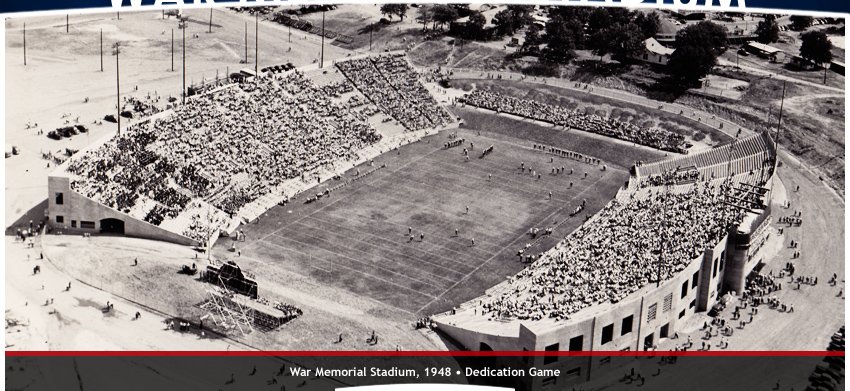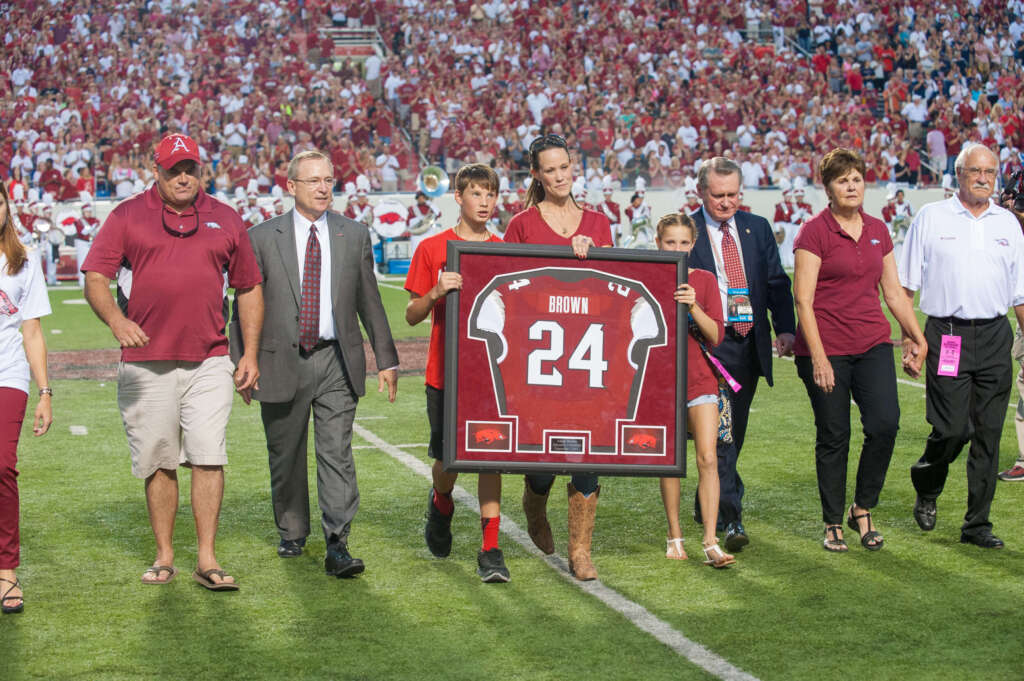

Home to Hogs, History and Heroes
For as long as a ball has been hit, kicked or tossed, sports has provided us far more than merely a showcase of athletic prowess. Beyond the wins and losses, the unforgettable moments and emblazoned memories, sports serve as an unofficial barometer of our culture. In events often categorized by a final score, sports often provide a real-time reflection of our society as we navigate through challenging times and complex issues.
At the intersection of sports and society you will discover revelations about who we are, what we value and aspirations for where we want to go. It is not an accident that through the years, sporting events have been the backdrop for some major cultural flashpoints. From a showing of solidarity on the medal stand by Tommie Smith and Juan Carlos in the 1968 Olympics to Major League Baseball player Rick Monday’s impromptu rescue of an American flag moments before it was set ablaze by demonstrators, sports has helped galvanize our feelings and give voice to our hopes for the future.
Sports has also provided a canvas to pay tribute to an all too often underappreciated segment of our society – those who serve our nation in military service. One of the most encouraging trends in sports in recent years has been the revival of event recognitions of veterans and active members of the military.
Whether it is a Military Appreciation Day, a flyover or simple recognition of an individual during a timeout, few moments bring us together more resolutely. When else can you witness a collective standing ovation from fans dressed in competing colors? Even in those moments, a splash of humanity is permitted for an otherwise neutrally pledged, universally scorned, group of game officials.
For the people of Arkansas, one sporting venue has long stood as a tribute to those who have paid the ultimate price in military service. Long before War Memorial Stadium became kindling for divisive social media brushfires, the Little Rock landmark was formed out of a melded resolve of Arkansans to honor those who died protecting our state and nation.
It was another flame of passion that initially got things moving. Razorback football was the driving force that inspired the idea for a new stadium. The Hogs played at Tiger Stadium, which was rapidly becoming obsolete to accommodate increasing crowds. Arkansas head coach John Barnhill noted after a 7-0 victory over Rice in 1946, that a new stadium was needed immediately.
The Arkansas legislature responded quickly by introducing a bill proposing a new stadium. The original bill was voted down, but a new financing plan was developed and a revised bill was passed in late 1947.
The legislature determined that the state government would purchase $500,000 worth of commission bonds while local interests would match the finances. Although the financing was set, the location of the new stadium was anything but a foregone conclusion.
Little Rock, North Little Rock, Hot Springs and West Memphis all mounted bond-selling campaigns to secure the new state-of-the-art venue. Eventually West Memphis dropped out of the race, but the other three communities offered sites and bond pledges in excess of the required amount specified by the legislature. The stadium commission determined that Little Rock would be the optimum site based on its central locality and its advanced network of roads from every corner of the state.
The architectural firm and construction crews were hired in the latter part of December 1947 and construction began on War Memorial Stadium. As the calendar hit July, the stadium construction seemed woefully behind. Only half of the stadium was completed with the first game set for mid-September. Additional workers were hired and days were lengthened and amazingly the stadium was ready for its debut. The new structure lacked many of the amenities that would later be added, but it was fit for action.
A $12,000 scoreboard was erected and a $5,000 public address system was installed. A luxurious press box and veteran’s lounge was created. The stadium housed 31,066 seats not including numerous bleacher sections. The cost of the state’s new football palace was $1.25 million.
Almost as quickly as plans for the new stadium were announced, a growing sentiment arose supporting that the new venue be dedicated to the men and women of Arkansas who gave their lives in World War I and II. The movement was indicative of the deep appreciation Arkansans hold for those who have perished in preservation of our freedom.
Arkansas and Abilene Christian christened the stadium on September 18, 1948. The Razorbacks led by Clyde Scott and Leon “Muscles” Campbell rolled over the Wildcats 40-6 in front of a record crowd of 24,950. Scott carried the ball 10 times and racked up 119 yards. The Hogs chewed up the Wildcats’ defense earning 307 yards rushing.
Coach Barnhill substituted freely and many of the Arkansas regulars played sparingly in the waning moments of the second half. Legendary sportswriter Orville Henry penned it best in the next day’s newspaper when he claimed that “Barnhill took a look at everyone, but the water boy as the Arkansas Razorbacks named their score over the Abilene Christian Wildcats.”
Perhaps the most vivid memory from opening day came at halftime when former Razorback end and Congressional Medal of Honor recipient Maurice “Footsie” Britt delivered the dedication address. Britt, who himself had lost an arm in the war, spoke eloquently about the sacrifice of Arkansans in the Great War. It was an emotional and fitting tribute, the first of many to come through the coming decades.
Since its debut in 1948, War Memorial Stadium has continued to be home to memorable games and stirring tributes to those who have served our nation. In 2008, on the 60th anniversary of War Memorial Stadium, the Sturgis Veterans Plaza was unveiled on the west side of the stadium. The plaza features a 25-foot “Stars and Stripes” sculpture that sits on a granite circle that is 40 feet in diameter. In the center are five columns from which five granite stars — each representing a branch of the military — are hoisted into the air. The sculpture is lit at night, establishing a grand, patriotic entrance into the stadium area.
In addition to the permanent tributes, numerous Military Appreciation Days have been held at the iconic venue through the years. In 2011, War Memorial Stadium was the canvas for a Red, White and Blue tribute, as fans dressed in coordinated colors to replicate “Old Glory,” the United States flag.
In 2013, a pair of decorated Arkansans were recognized as part of Military Appreciation Day festivities during an Arkansas football game against Samford. The Razorbacks honored fallen Arkansas hero Adam Brown, a Navy SEAL Chief from Hot Springs and Milton Crenchaw, a Little Rock native and original member of the legendary Tuskegee Airmen. Brown’s family and Crenchaw stood on the War Memorial turf as the Razorback Nation stood in unison to applaud their contributions.
If the walls of War Memorial Stadium could talk, they would undoubtedly speak of countless tales of Hogs, History and Heroes. This Miracle on Markham, located geographically in the center of our state, resides figuratively at the heart of Arkansans’ perpetual debt of gratitude.
More than 70 years since it first opened, War Memorial Stadium continues to serve as a testament to the selfless service of generations of Arkansans. And most importantly, it stands as an enduring tribute to the sacrifice and memory of our fallen heroes.
Razorback Road is a column written by Senior Associate Athletic Director for Public Relations and Former Student-Athlete Engagement Kevin Trainor (@KTHogs). Trainor is a graduate of the University of Arkansas and has worked for Razorback Athletics for more than 25 years.




